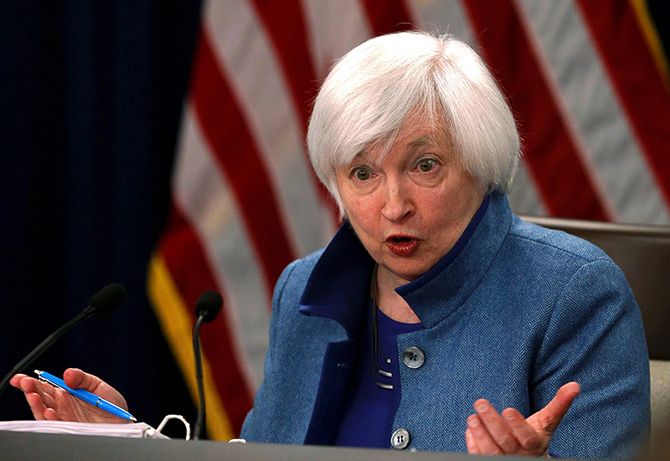Hawkish guidance by the US Fed raises concerns it could tie the hands of RBI from trimming rates.

Image: US Federal Reserve chair Janet Yellen holds a news conference following day two of the Federal Open Market Committee meeting in Washington, DC, on December 14, 2016. Photograph: Gary Cameron/Reuters.
Bonds, stock and rupee came under pressure after the US Federal Reserve hiked its policy rate by 25 basis points (bps) and guided that there could be three more hikes next year, instead of the widely expected two, as the US economy shows early signs of a pick-up in growth.
The hawkish guidance by the US Fed raised concerns it could tie the hands of the Reserve Bank of India from cutting rates aggressively.
The central bank had paused on December 7, anticipating an imminent hike by the Federal Open Market Committee, and waiting to see how the hike would impact the financial markets. If the US goes ahead with three hikes as guided, RBI may end up cutting rates by not more than 50 bps as otherwise the interest rate differential will become unattractive for foreign investors to put money here.
Following the rate hike by the US FOMC, rupee shed 0.58 per cent of its value against the greenback, as US dollar index shot up to a near 14-year high of 100.57. The local currency closed at Rs 67.84 a dollar, from its previous close of 67.45 a dollar. Japanese yen lost 0.90 per cent and South Korean won lost 0.72 per cent against the dollar.
The projected faster-than-expected pace of tightening next year triggered a huge jump in two-year US treasury yields. Higher US yields and stronger dollar is negative for Asian and emerging markets, as it triggers capital outflows from investors looking to benefit from the rising yields in the US.
The prospects of a less rate cut by RBI pushed up Indian bonds yields too. The benchmark 10-year bond yields rose a steep 11 bps to close at 6.52 per cent. One basis point is a hundredth of a percentage point.
“If the US Fed rate hike plans materialise and crude oil prices remain firm, the scope for rate cuts by RBI gets limited. RBI may limit its cut to 25 bps, or at maximum 50,” said Arvind Narayanan, executive director, and head of treasury and sales at DBS Bank in India.
According to Arvind Sampath, head of treasury at FullertonIndia, RBI will still follow the local macroeconomic factors, rather than Fed cues.
“Inflation is down, IIP (index of industrial production) is down, PMI (purchasing managers’ index) is down, economic growth is sluggish… there is no reason to expect that RBI will not give adequate rate support,” said Sampath.
Both Narayanan and Sampath said the bond and currency reaction could be ‘knee jerk’ and should soon rectify.
Equity market experts also hold the same view about the short-term movement in the indices.
“The markets have already factored in the possibility of a Fed hike. Even if there are three hikes next year, the impact on Indian markets could be minimal if corporate earnings show improvement. Overseas flows, however, could get impacted in the short time and should pick up once again,” said Raamdeo Agrawal, joint managing director, Motilal Oswal Financial Services.
The reaction in the stock markets was relatively muted with the benchmark indices declining less than half a per cent. The Nifty 50 ended 0.35 per cent lower at 8,153.6, while the Sensex closed 0.31 per cent lower at 26,519.1. Analysts said markets had priced in a quarter-point increase but saw volatility due to projection of three rate hikes in 2017.
On Thursday, foreign institutional investors sold shares worth Rs 612 crore from the equity market. If the US dollar and Treasury continues to gain, the domestic market could see more outflows and weakness, analysts said.
Indian markets outperformed its Asian peers, thanks to its superior economic growth and high forex reserves, experts said. Markets will take cues on whether the new Republican government pushed ahead, with its promised infrastructure plan and other pro-growth initiatives, they added.












 © 2025
© 2025